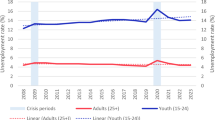Abstract
Using public-use microdata samples from the American Community Survey, we find that Middle Eastern Arab men and Afghan, Iranian, and Pakistani men experienced a significant earnings decline relative to non-Hispanic whites between 2000 and 2002. Further analyses based on the Juhn–Murphy–Pierce wage decomposition technique as well as quantile regression indicate that this earnings decline is not explained by changes in the structure of wages or in observable characteristics beyond ethnicity. Our interpretation is that the unanticipated events of September 11th, 2001 negatively affected the labor-market income of the groups most closely associated with the ethnicity of the terrorists.




Similar content being viewed by others
Notes
An important example of a natural experiment to study labor markets is Card’s (1990) analysis of the impact of the sudden increase in the supply of labor on a region’s native wages resulting from the Marielito migration to Miami in 1980. This paper takes a similar approach in that it explores the labor-market impact of a sudden shock on the earnings of workers most likely identified as having ethnic ties to suspected 9-11 terrorists.
We construct a continuous education measure by taking the midpoint of the education categories in the ACS, or where possible, the average number of years related to certain schooling levels (e.g., 16 years for a college degree).
A closer perusal of the PUMS ACS data indicates that the share of Arab men between the ages of 25 and 40 who were not working increased during this same time period relative to non-Hispanic whites: 8.8% of Middle Eastern Arab men and 4.0% of non-Hispanic white men did not work in 2000, increasing to 11.6% (Middle Eastern Arab men) and 4.6% (non-Hispanic whites) in 2002. Similarly, the share of Middle Eastern Arab male workers employed for less than 20 h per week increased from 11.2 to 16.1% between 2000 and 2002, compared to an increase from 7.5 to 9.1% for non-Hispanic white employees. While non-wage issues related to changes in the employability of Arab vis-à-vis non-Hispanic white men following 9-11 go beyond the scope of this study, they serve as interesting fodder for future research.
Recall that the focus of this study is on younger men. When expanding the samples to include workers between the ages of 25 and 64, the estimation of Eq. 1 indicates that Middle Eastern Arab men continued to experience a significant (at the 5% level) average earnings decline relative to non-Hispanic white men; the coefficients (standard errors) on Middle Eastern Arab were −0.198 (0.056) for 2000 earnings and −0.454 (0.118) for 2002 earnings. The average earnings decline among Afghan, Iranian, and Pakistani men, however, is no longer statistically significant at conventional levels in the broader sample [coefficient (standard error)=−0.351 (0.072) for 2000 and −0.392 (0.066) for 2002].
For example, Human Rights Watch (2002) notes that working relationships and networks between local law enforcement agencies and the community enable the law enforcement to gain intelligence and quickly deploy forces into “sensitive” areas following a terrorist event, thus mitigating the potential backlash against a particular ethnic group. Moreover, individuals in communities with such relationships with local officials might feel more comfortable in reporting discriminatory acts.
References
American–Arab Anti-Discrimination Committee (2003) Report on hate crimes and discrimination against Arab Americans: the post September 11 backlash, September 11, 2001–October 11, 2002. In: H. Ibish (ed). ADCRI, Washington. http://www.adc.org/hatecrimes/pdf/2003_report_web.pdf
Becker GS (1971) The economics of discrimination. University of Chicago Press, Chicago
Blau FD, Kahn L (1994) Rising wage inequality and the US gender gap. Am Econ Rev AEA Pap Proc 84(2):23–28
Blau FD, Kahn L (1997) Swimming upstream: trends in the gender wage differential in the 1980s. J Labor Econ 15(1):1–42
Card D (1990) Impact of the Mariel boatlift on the Miami labor market. Ind Labor Relat Rev 43(2):245–257
Human Rights Watch (2002) We are not the enemy: hate crimes against Arabs, Muslims, and those perceived to be Arab or Muslim after September 11. US 14(6):1–41. Available at http://www.hrw.org/reports/2002/usahate/usa1102.pdf
Juhn C, Murphy KM, Pierce B (1993) Wage inequality and the rise in the returns to skill. J Polit Econ 101(3):410–42
Kennedy P (1981) Estimations with correctly interpreted dummy variables in semilogarithmic equations. Am Econ Rev 71(4):801
Koenker R, Hallock KF (2001) Quantile regression. J Econ Perspect 15(4):143–156
Marshall R (1973) The economics of racial discrimination: an overview. J Econ Lit 12(3):849–71
Phelps E (1972) A statistical theory of racism and sexism. Am Econ Rev 62(4):659–61
Stiglitz JE (1973) Approaches to the economics of discrimination. Am Econ Rev AEA Pap Proc 63(2):287–95
US Bureau of the Census (2003) The Arab population: 2000 (Census 2000 Brief), C2KBR-23, issued December 2003. US Government Printing Office, Washington D.C.
US Bureau of the Census (2004) American Community Survey 2000–2003: public-use microdata. Data downloaded from http://www.census.gov/acs/www/Products/PUMS/pums2002.htm on August 30, 2004 (webpage last revised on August 25, 2004)
Author information
Authors and Affiliations
Corresponding author
Additional information
Responsible editor: Klaus F. Zimmermann
Rights and permissions
About this article
Cite this article
Dávila, A., Mora, M.T. Changes in the earnings of Arab men in the US between 2000 and 2002. J Popul Econ 18, 587–601 (2005). https://doi.org/10.1007/s00148-005-0050-y
Received:
Accepted:
Published:
Issue Date:
DOI: https://doi.org/10.1007/s00148-005-0050-y




